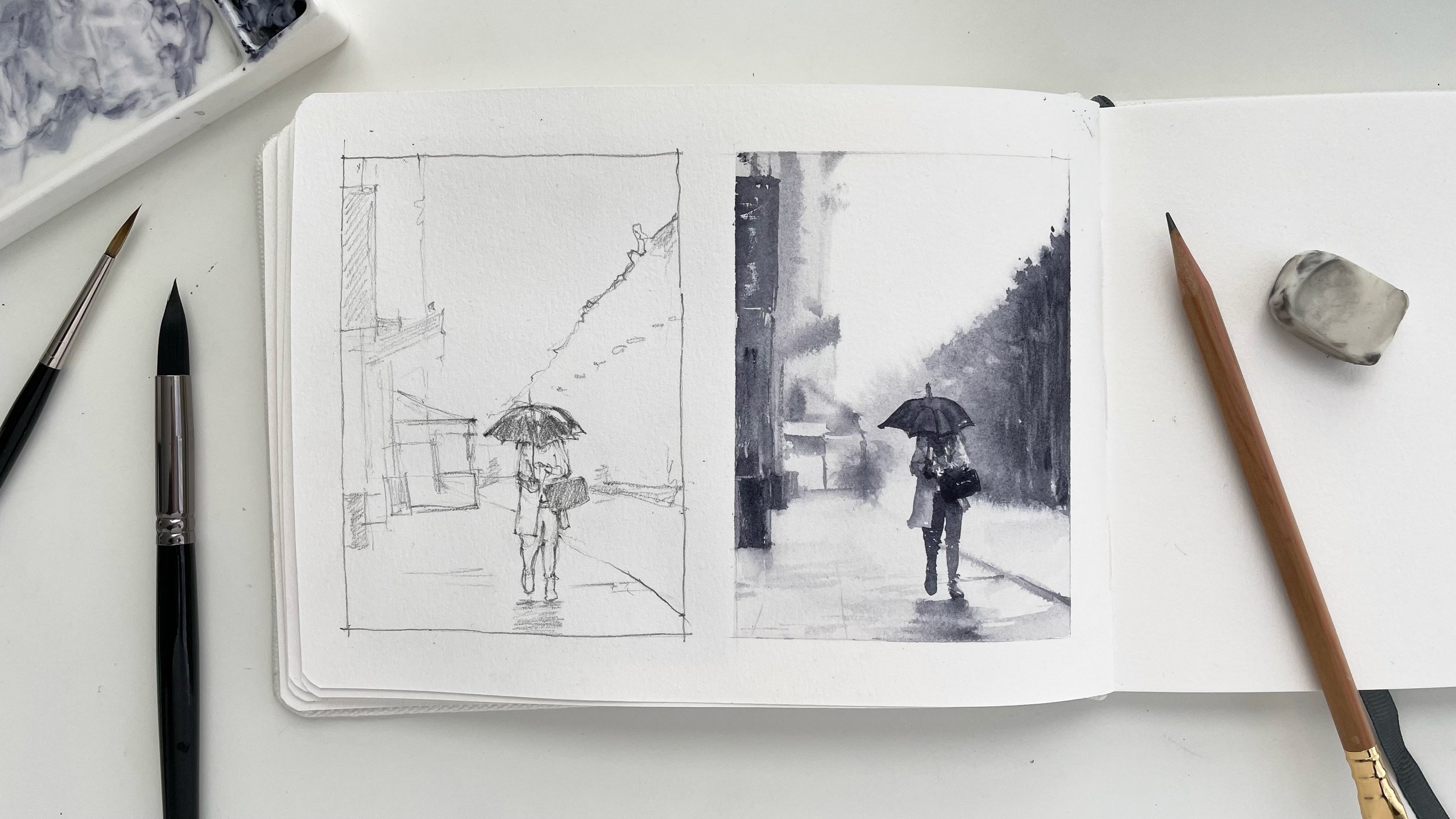How to Paint a Rainy Day Scene in Watercolor
I think it’s interesting that this rainy day scene doesn’t actually involve painting raindrops. It’s about finding a way to capture the effects that all those raindrops have on the environment they are falling on.
For this painting I decided to just “go for it” with paint. Without any sketch or preliminary lines. You can see that I did a practice sketch prior to painting and I’m also painting right next to my practice sketch, which I found helpful to have as a reference.
If you’d like to see the practice sketch for this scene and hear about why I find sketching to be helpful prior to painting, click here to see the blog post and video.
Below I’ll do my best to describe how to approach a rainy day scenes by sharing how I approached this one in particular.
Picking Your Scene
Ok so let’s just get started with the obvious: I picked a reference photo with a person walking with an umbrella. That’s a dead giveaway that this is a rainy day scene! I’m all about the idea of setting ourselves up for success. Creating art should be fun and fullfilling. And if it takes picking an “obvious” photograph to help us get that much closer to painting something we can be proud of and further our progress, then why not?
So if you’re setting off to practice a rainy day scene, I say, pick one where it’s obvious that it’s raining! Here’s a link to the reference photo I used.
Do A Practice Sketch (if you want)
As I mentioned above, sometimes I find it helpful to do a sketch prior to painting. It helps me think and work through different aspects of the scene and helps with the next step - thinking through techniques I’ll use.
Review Techniques You’ll Use
As we know, it’s hard to know exactly what happens when your water and paint begin moving on the paper, but it’s good to stop and think through what techniques will be used and a rough order in which you’ll be painting in. For a rainy day scene, some key things I consider when looking at my subject:
Where are the softed or most distant areas? This is where I’ll use wet-on-wet.
Where are the reflections on the wet surfaces? These are key areas to capture.
Where is the focus of the painting? This is where there will be hard edges and I’ll do them when the paper is dry or almost dry.
Use Wet-On-Wet
For a rainy day painting, using wet-on-wet is going to be a given for me. For this painting, I definitely wet the entire area of the painting to lay down all the blurry effects first.
There is an “order” for what elements I put in wet, and it kinda goes something like this:
Lightest and most blurry elements go in first, when you have the least “control”. This is usually the most distant elements or the background of the painting.
Darker more middle-ground elements next. This is done as the wet areas begin to become less wet, when there is a bit more control.
Use Lifting
Lifting can be a subtle but impactful way to add details while a painting is still in a wet stay but hasn’t dried yet. In this painting, it allowed me to add some subtle details and is also a great way to add even small lines or textures that might be reminiscent of “rain streaks”, if your painting calls for that.
Add Hard Edges
The “final” step after all the wet-on-wet, blurry work has been done is to add in the hard edges. Usually this is the foreground or focal point of the painting. In this case, the figure was the element I painted after drying the painting completely after finishing the blurry background.
For me, watercoloring is hard to explain as as step-by-step process. I’ve tried my best to describe the general order of things, but as you may know, there is a lot of back and forth that goes on when painting.
It really will come down to timing and where the painting takes you. In other words, your own intuition as to where you want to or need to go next.
You can watch the painting process of my rainy day scene in the video below:
I hope that my process explanation for this rainy day scene was helpful! Let me know in the comments if you have any questions!
Susan


